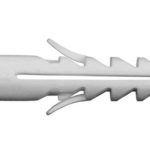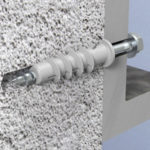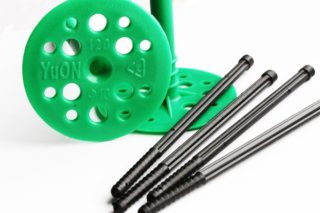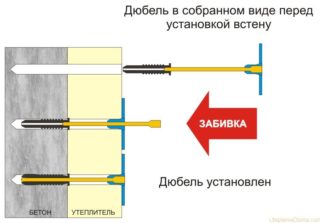Reliable fixing of the insulation is an obligatory step in creating a thermal insulation of a room. As insulation material, soft, loose and porous sheets or mats are selected, which are easy to fix. With small volumes, they are fixed on glue or simply laid between the bars. In the case of bulky construction work, it is necessary to use special fasteners - dowels. They differ in the method of fastening, material of manufacture, length and diameter. Before starting work, it is necessary to choose the right holders for thermal insulation.
Types of clamps
The insulation is a heterogeneous multilayer material, often with a porous structure. The difficulty of fixing it is the risk of violating the integrity of the structure, especially when using waterproofing and vapor barrier. For this reason, latches are divided into two main groups:
- dowels for facade work and wall insulation;
- dowels for roof insulation.
The first type of fasteners is an integral or collapsible design in the form of a mushroom. Collapsible consists of a sleeve with a spacer, a head in the form of a clamping disk and a rod. The expansion bolt shield for warming differs from usual only in the increased head volume. The diameter of the disc is 45-90 mm. It is made of various types of plastic and metal.
The second type of dowels is a hollow plastic rod with a wide clamping disk. It has a special installation method - in the body of the heat insulator. The nail passes through and immersed in concrete or other dense material.
Criterias of choice
The quality of fastening the material to the surface depends on the correct choice. When choosing dowels, you need to pay attention to several factors:
- Length. It depends on the thickness of the insulator and other layers, the deviation of the wall from the vertical, the minimum allowable recess.
- Breakout load.
The shape also depends on the material. Lightweight heat insulator does not withstand rigid mounting.
Varieties of dowels
Dowels can be classified according to several criteria - by design, material and design. The choice depends on the characteristics of the insulation itself.
Design
There are two main mounting methods:
- Indisputable. The dowel does not need a hardware. Fasteners are installed in a pre-drilled hole through the insulation.
- Spacer. A nail or screw is driven or twisted into the body of the rod. A hole is pre-made under the rod into which it must be placed.
- Spacer
- Indisputable
The first option is used for cellular concrete, and the second for dense materials (brick, concrete).
Production material
The dowel itself is made from different types of plastics. Metal is prohibited due to high thermal conductivity. A screw or nail is made of plastic or metal.
The main types of plastics for dowels:
- Nylon or polyamide. It is a lightweight material with a high degree of strength. It can be used for mounting on any surface. The maximum allowable load on the fasteners for insulation is 120 kg. Working - 30 kg.
- Polypropylene. It features high strength and hardness. The load reaches 150 kg.
- Fiberglass reinforced polyamide. This is a new material that has the same strength as metals.It has low thermal conductivity, making it a higher priority material than metal parts.
The spacer rod can be made of the same plastic as the dowel-mushroom for thermal insulation, or of metal.
The following materials are used from metals:
- Galvanized steel. The thickness of the zinc layer should be at least 6 microns. It is used in normal conditions with a normal level of humidity.
- Stainless steel. This is a more expensive fixative, but it is not susceptible to corrosion. The main scope of the use of steel holders is places with a high level of humidity.
By design, there are:
- The nail and the dowel are made of one type of plastic. It is not recommended to use different types, since their thermal expansion coefficients will vary. A dowel for thermal insulation with a plastic nail is used in almost all climatic conditions.
- The dowel is made of plastic, the shaft is made of metal. The fastening strength is increased, but the metal conducts heat. This leads to the formation of a cold bridge.
- Plastic expansion bolt shield fungus for a heater and a core from metal with a thermal head. This design avoids the appearance of a cold bridge. The screw cap is covered with a nylon cap, and the nail is inside.
Each of the combinations of dowel-nails for thermal insulation has its positive and negative sides, as well as its own cost. The choice depends on the climatic characteristics of the room in which the insulation is made.
Product Dimensions
There are no GOST standards for plastic dowels, but for polyamide products they exist. The document spells out which brand of plastic can be used and in what macroclimatic conditions.
Fasteners for thermal insulation should be of sufficient length. This is due to the deepening through several layers of thermal insulation. The sizes of other parts vary in a small range:
- cap diameter - from 45 mm to 90 mm;
- 2 rod diameters - 8 mm and 10 mm each;
- lengths from 40 mm to 400 mm.
The bearing capacity depends on the strength of the retainer and the material of the walls. The load can range from 0.3 kN to 23 kN.
Length calculation can be done according to the formula L = H + I + K + W. L - dowel length N - insulation thickness TO - the thickness of the layer of plaster or glue (if any), I - additive for fixing in concrete / brick / wood (50 mm), W - stock.
When using a foam material with a thickness of 50 mm installed on a 5 mm adhesive layer, a dowel length of 110 mm is required. In the case of a curved wall with a bias of 50 mm, the size will increase to 160 mm by the corresponding value. For a double layer of insulation, a 210 mm dowel is needed.
Excessive length is not always a positive factor. This must be taken into account when warming thin walls in an apartment.
Well-known manufacturers
The leading manufacturers of dowels for insulation are companies from Germany, Russia and Poland. The most famous companies include:
- Termoklip. The company supplies products to Russia and the CIS countries made of carbon steel coated against rust. Dowels of several series made from block polymer are available. Some models have a heat-insulating cover.
- Isomax It produces dish-shaped dowels with a diameter of 10 mm. The nail is made of carbon steel with galvanized coating. It is possible to install a thermal head.
- Tech-Krep. The Russian manufacturer supplies plastic fasteners in various versions. They can have a plastic or metal nail, a thermal cover. They have a complex chemical composition. The steel nail has a galvanized coating.
All products have the necessary certificates and licenses for installation work.
Installation work
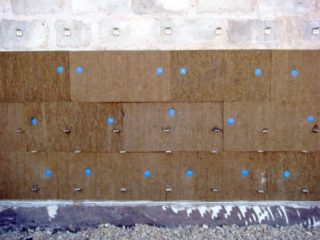
First of all, it is necessary to calculate how many dowels are needed, what length and diameter they should have. It depends on the insulation. Its weight is practically irrelevant, thickness and degree of looseness are important.
The length of the fasteners for the insulation of the mushroom depends on several parameters. The thickness of the insulation sheet, adhesive layer, vapor barrier, waterproofing. It is also necessary to take into account the deviation from the vertical and the maximum possible deepening into the wall. All these criteria must be indicated in the documentation and the size is selected according to them.
The diameter of the cap is determined by the degree of looseness of thermal insulation. This criterion is approximate, the exact values are not indicated anywhere. If the insulation is light and loose in structure, the diameter should be large. In the case of laying foam, you can pick up dowels with a small head. For laying mineral wool, the largest caps are chosen.
The number of fasteners depends on the weight of the heat-insulating plates and the possible load of the plate-shaped dowel for fixing the insulation. There should be at least 5 on one plate - 4 are mounted in the corners, 1 at the center point.
All these values apply if the inside of the house is insulated.
If the insulation will be mounted on the facade, it is necessary to take into account the wind load. The number of fasteners increases, there must be at least 6, located in two parallel rows. If the building has a height of up to 20 meters, per 1 sq.m. accounts for 7 dowels. With a height of more than 20 meters, the consumption of fasteners increases to 9 pieces.
Fastening technology
The heat insulator is laid on the surface at an intermediate stage of installation. First, the frame is laid from wooden blocks, between which insulation sheets are placed. The complexity of the installation work is the need to take into account all the nuances of the mounting mechanisms in advance. If the ceiling with plaster is insulated, the depth of installation of the dowel of the umbrella should be increased.
The insulation itself is fixed with glue (in the case of polyurethane foam, polystyrene foam and expanded polystyrene) or completely in the resulting cells of the frame (for mineral wool). On each panel, it is necessary to mark the places in which the holder will be installed. A hole of a certain depth is drilled with a margin of 10-15 mm. If you do not add this stock, fungi for attaching the insulation will not hold the insulation material well.
A dowel for insulation is installed in the resulting hole. Its head in the form of a disk should slightly press the insulation. If there is a nail, you need to drive it. In the case of a screw, the screw installation method is used. The fungal head is covered with a cap, if it is provided in the design.
It is recommended to choose the place of joints for fastening. This will reduce the number of holes and slots through which heat is removed. Also, during facade work, all seams are closed with a special aluminum reinforcing tape.


